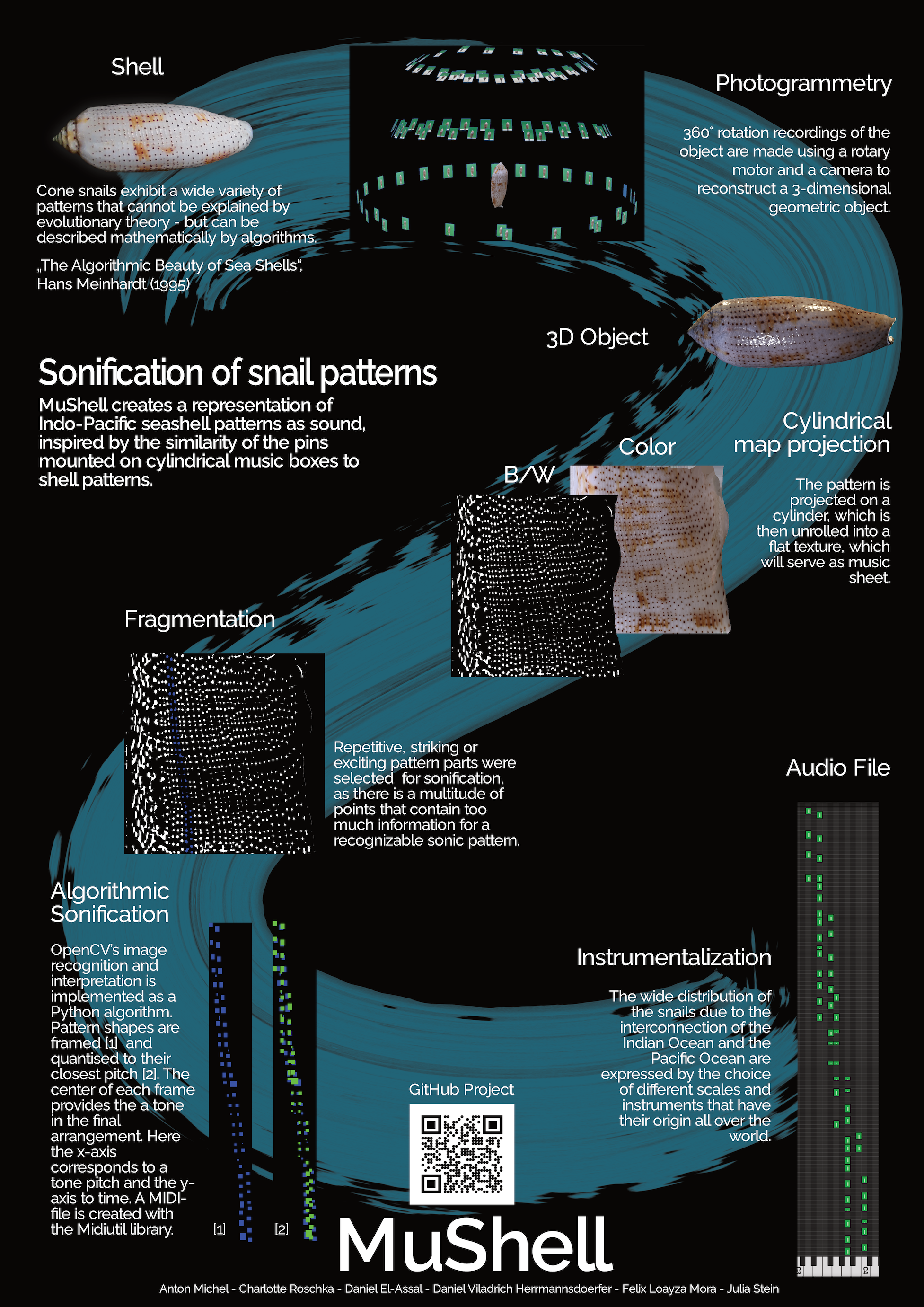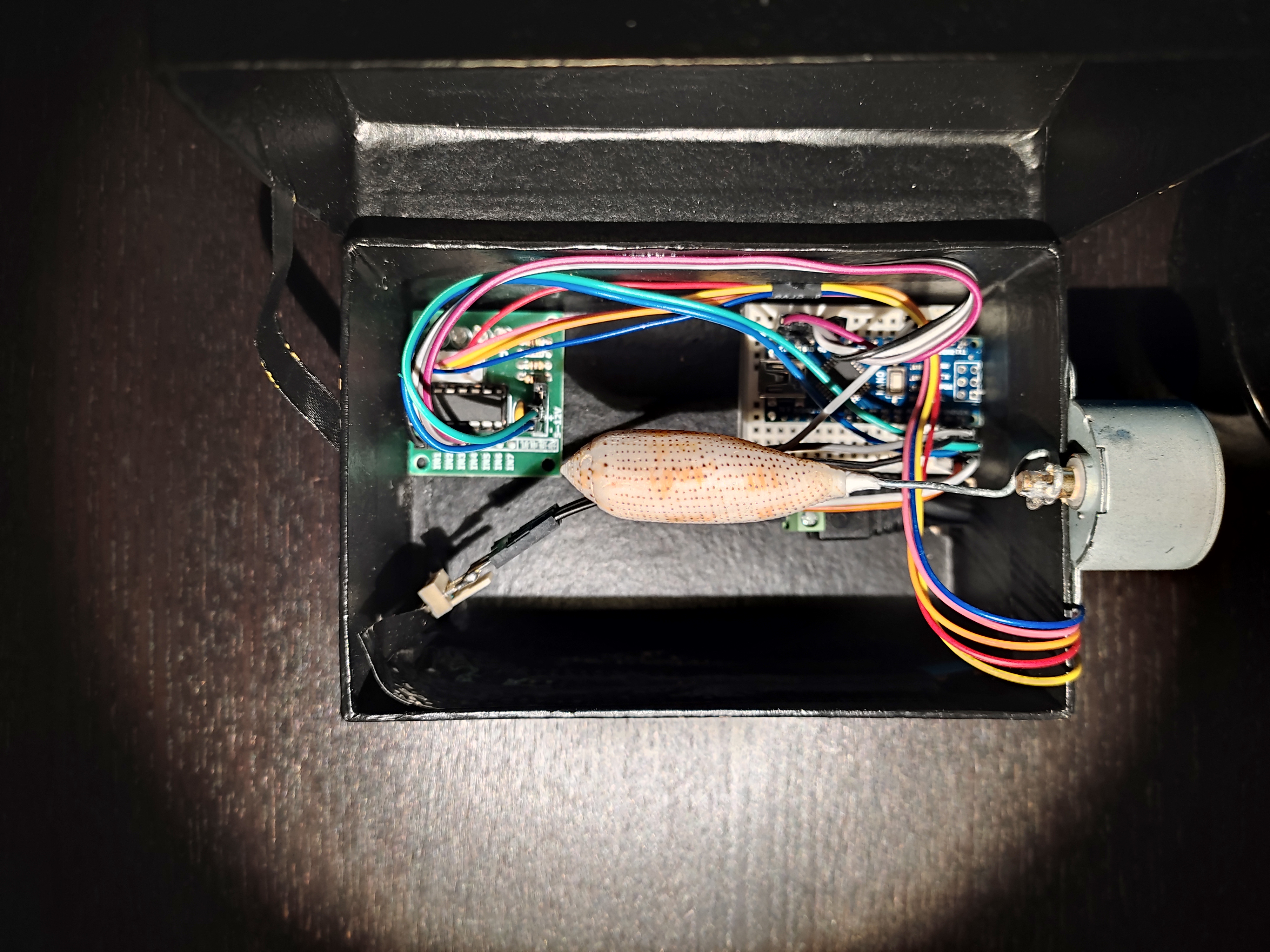MuShell
Music of the Shells

MuShell explores the musicalization of snail shell patterns, which are created by the activation and inhibition of pigment
production, regulated by underlying processes. The group project was inspired by the similarity of some sea snails to cylindrical music boxes. The dots on the surface of the shell resemble the pins on the cylinder surface. This led to the core question of the project: How can the patterns from nature be made audible?
production, regulated by underlying processes. The group project was inspired by the similarity of some sea snails to cylindrical music boxes. The dots on the surface of the shell resemble the pins on the cylinder surface. This led to the core question of the project: How can the patterns from nature be made audible?
The process of sonification of the snail shells involved photogrammetry to create a 3D model from approximately one hundred photographs, procedural 3D modeling to render the pattern as a flat image, image processing to extract the relevant patterns, and further data processing in Python to convert these patterns into MIDI files. Final instrumentation of the generated MIDI files was done in GarageBand.



Sound Design
During the process, many decisions had to be taken. Since the snails are distributed throughout the entire Indo-Pacific, the sonification was not to be implemented with exclusively Western scales.
However, in the sonification process, the limitations of digital music production tools became apparent. The 127 different levels of a MIDI file are read in by most DAWs (Digital Audio Workstations) as notes of the Western 12 TET system. This standard behavior can only be changed with specialized plug-ins for microtonal music and has led to the necessity to adapt the translation of the point coordinates into notes to the scales of the 12 TET system. This shows the bias of the conception of modern music production.
The last step again contains a lot of interpretation and decision making, as the received MIDI files were equipped with instruments and modulations in GarageBand according to subjective taste. Both traditional and modern synthetic sounds were used, which can best reproduce the pattern of the shell artistically and educationally. For fine patterns with a high density of dots, staccato sounds are more suitable; for coarser patterns, flowing sounds fit better.
However, in the sonification process, the limitations of digital music production tools became apparent. The 127 different levels of a MIDI file are read in by most DAWs (Digital Audio Workstations) as notes of the Western 12 TET system. This standard behavior can only be changed with specialized plug-ins for microtonal music and has led to the necessity to adapt the translation of the point coordinates into notes to the scales of the 12 TET system. This shows the bias of the conception of modern music production.
The last step again contains a lot of interpretation and decision making, as the received MIDI files were equipped with instruments and modulations in GarageBand according to subjective taste. Both traditional and modern synthetic sounds were used, which can best reproduce the pattern of the shell artistically and educationally. For fine patterns with a high density of dots, staccato sounds are more suitable; for coarser patterns, flowing sounds fit better.


 .
. MuShell was created within a group project. I had the main responsibility for the sound and poster design. Electronics, research and documentation were done by me in half parts. The photogrammetry part was divided into photographing the snails, which we did together as a group, and the masking of the snails in the photos and the calculations by the photogrammetry program, which again I contributed half of. In the coding of the programs I took an assisting role on this occasion.
Exhibition
To showcase the project, custom music boxes were built. The snail is rotated by an Arduino-controlled stepper motor, while viewers can listen to the soundtrack of the patterns through headphones. In addition, LEDs mounted in the music box indicate the note played simultaneously in the melody by lighting up at the representative point of the octave. The MuShell boxes were exhibited as part of the “Soft Encounters” exhibition from 14.-17. October 2021. The MuShell snails were exhibited on the 2nd of July 2022 at the Long Night of Science 2022 in Berlin at the Museum of Natural History.
Additional Links
Blog Entry by Christel Clerc at the Website of Mediasphere for Nature
Blog Entry by the MuShell Team at the Website of Mediasphere for Nature
Blog Entry by MuShell Team at the Website of lab:prepare
MuShell Github-Repository
Ausstellungsflyer “Soft Encounters”
Animated MuShell Videos
Music Box MuShell Videos
Blog Entry by the MuShell Team at the Website of Mediasphere for Nature
Blog Entry by MuShell Team at the Website of lab:prepare
MuShell Github-Repository
Ausstellungsflyer “Soft Encounters”
Animated MuShell Videos
Music Box MuShell Videos